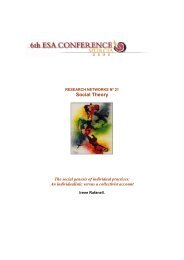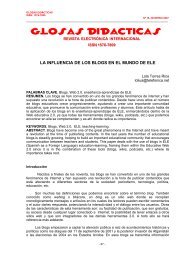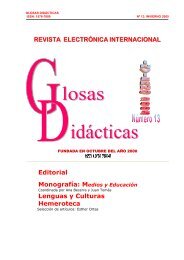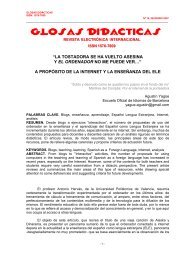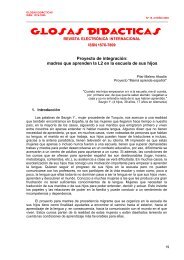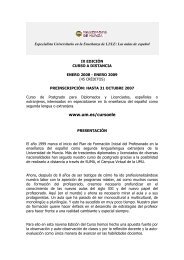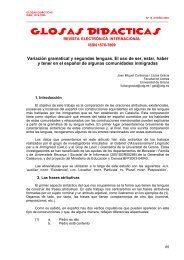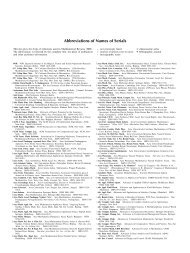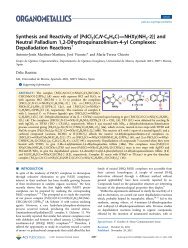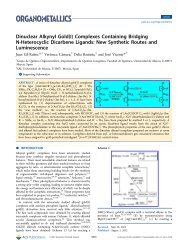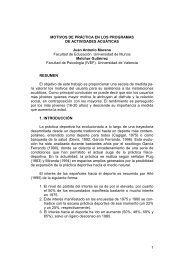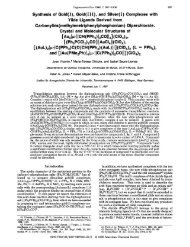New Acetonyl Palladium(II) Complexes - Universidad de Murcia
New Acetonyl Palladium(II) Complexes - Universidad de Murcia
New Acetonyl Palladium(II) Complexes - Universidad de Murcia
Create successful ePaper yourself
Turn your PDF publications into a flip-book with our unique Google optimized e-Paper software.
3984 Organometallics, Vol. 27, No. 15, 2008 Vicente et al.<br />
Table 1. Crystallographic Data for <strong>Complexes</strong><br />
3 8 11 13<br />
formula C 13H 15ClN 2OPd C 22H 28F 3N 3O 5Pd S C 20H 23ClN 2OPd C 11H 17ClOPd<br />
fw 357.12 609.93 449.25 307.10<br />
cryst habit lath block block block<br />
cryst size (mm) 0.54 × 0.30 × 0.10 0.40 × 0.20 × 0.20 0.32 × 0.22 × 0.08 0.21 × 0.20 × 0.17<br />
cryst system triclinic monoclinic triclinic orthorhombic<br />
space group P1 P2 1/c P1 Pbca<br />
cell constants<br />
a (Å) 8.2358(6) 14.0831(12) 7.956(5) 8.2836(8)<br />
b (Å) 8.817(2) 11.5607(11) 9.980(5) 13.7315(7)<br />
c (Å) 10.974(2) 16.9448(14) 12.514(5) 19.6036(11)<br />
R (<strong>de</strong>g) 73.534(5) 90 97.255(5) 90<br />
β (<strong>de</strong>g) 87.561(5) 112.467(4) 105.519(5) 90<br />
γ (<strong>de</strong>g) 63.968(5) 90 103.746(5) 90<br />
volume (Å 3 ) 683.6(2) 2549.4(4) 910.6(8) 2229.8(3)<br />
Z 2 4 2 8<br />
λ (Å) 0.71073 0.71073 0.71073 0.71073<br />
F calcd (Mg m -3 ) 1.735 1.589 1.638 1.830<br />
µ(Mo KR) (mm -1 ) 1.541 0.869 1.176 1.868<br />
F(000) 356 1240 456 1232<br />
T (K) 173(2) 133(2) 100(2) 173(2)<br />
2θ max (<strong>de</strong>g) 50 60 52.7 50<br />
no. of reflns measd 2523 39 875 10 018 3827<br />
no. of in<strong>de</strong>p reflns 2354 7461 3691 1962<br />
transmissions 0.8611 and 0.4899 0.862 and 0.700 0.9118 and 0.7047 0.7418 and 0.6950<br />
R int 0.008 0.029 0.0143 0.0307<br />
abs corr psi-scans semiempirical from equivalents semiempirical from equivalents psi-scans<br />
no. restrnts/params 2354/136/164 560/386 0/227 88/128<br />
R w(F 2 , all reflns) 0.0425 0.0910 0.0582 0.0446<br />
R(F, > 4σ(F)) 0.016 0.0320 0.0217 0.0232<br />
S 1.07 1.049 1.13 0.84<br />
max ∆F (e Å -3 ) 0.32 1.11 0.33 0.40<br />
been obtained by reacting alkyl, 20,28 aryl, 21 or acyl 28 palladium<br />
<strong>de</strong>rivatives with allenes.<br />
All attempts to react acetonitrile solutions of 1 with heterocumulenes<br />
(CS 2 and RNdCdS) or alkynes (diphenylacetylene<br />
and dimethyl acetilendicarboxylate) were unsuccessful, and<br />
the starting compounds or complex mixtures of products were<br />
obtained.<br />
Crystal Structures. The crystal structures of complexes 3<br />
(Figure 1), 8 (Figure 2), 11 (Figure 3), and 13 (Figure 4)<br />
have been solved. The palladium atoms are in an almost<br />
square-planar coordination. The <strong>de</strong>creasing trans influence<br />
of the ligands alkyl > acetonyl > olefin > chloro > pyridine<br />
≈ bpy is shown by comparing the metal-to-donor atom bond<br />
distances. Thus, Pd-N bond distances trans to: py or bpy in<br />
3 or 8 (2.0269(2)-2.0328(2) Å) < chloro in 11 (2.0753(17)<br />
Å) < acetonyl in 8 (2.1202(19) Å) < alkyl in 11 (2.1518(18)<br />
Å); Pd-C olefin bond distances in 13 trans to: Cl (2.193(3),<br />
2.178(3) Å) < acetonyl (2.358(3) and 2.329(3) Å); Pd-Cl<br />
bond distances trans to: bpy in 11 (2.3069(12) Å) < olefin<br />
in 13 (2.3268(9) Å) < acetonyl 3 (2.3869(6) Å); and Pd-CH 2<br />
bond distances trans to: t Bupy in 8 (2.056(2) Å) < olefin in<br />
13 (2.072(3) Å) ≈ chloro (2.0804(19) Å).<br />
The structure of 11 shows the exo insertion of norbornene<br />
into the Pd-acetonyl bond. The CdO (1.210(3) Å) or CH 2 -CO<br />
(1.510(3) Å) bond distance in 11 is slightly shorter or longer,<br />
respectively, than in 3 [1.232(3), 1.460(3) Å, respectively], 8<br />
[1.229(3), 1.464(4) Å, respectively], or 13 [1.225(4), 1.467(5)<br />
Å, respectively]. In general, CdO and CH 2 -CO bond distances<br />
inotheracetonylmetalcomplexesareintheranges1.209(3)-1.232(5)<br />
and 1.475(4)-1.516(5), respectively. 2–5,7 The molecules of 11<br />
associate in dimers through a π ···π stacking of the bpy rings<br />
with a centroid-centroid distance of 3.450 Å.<br />
(28) Ruelke, R. E.; Kliphuis, D.; Elsevier, C. J.; Fraanje, J.; Goubitz,<br />
K.; van Leeuwen, P. W. N. M.; Vrieze, K. J. Chem.Soc., Chem. Commun.<br />
1994, 1817.<br />
Spectroscopic Properties. The 1 H NMR spectra of complexes<br />
show the methyl proton resonances in the wi<strong>de</strong> range<br />
1.21-2.53 ppm <strong>de</strong>pending on neighboring group effects. Thus,<br />
in 10, some of the aryl groups of the phosphine ligand cause<br />
the maximum shielding (1.21 ppm); in trans-3-5 and 7-9, the<br />
pyridine ligands lead to an intermediate shielding (1.72-1.78<br />
ppm), while in cis-3, cis-4, 6, and 11-14 the lower shielding<br />
is reached (2.07-2.53 ppm). The methylene acetonyl protons<br />
appear as singlets in the range 2.51-3.00 for complexes 3-9<br />
and 13. Those of complex 2 give a doublet of doublets at 2.70<br />
ppm, and the 31 P{ 1 H} NMR spectrum consists of two doublets,<br />
in agreement with the proposed structure. For CDCl 3 solutions<br />
of complexes 3-5, 1 H and 13 C NMR spectra, HMQC, and<br />
NOESY 2D experiments reveal they are 10-12:1 mixtures of<br />
trans/cis isomers. In the 1 H NMR spectra of complex 10, the<br />
CH 2 C(O) protons appear as a doublet of triplets and the 31 P{ 1 H}<br />
NMR shows a triplet and a doublet for the P atoms trans and<br />
cis to the acetonyl ligand, respectively. The insertion of<br />
norbornene into the Pd-CH 2 bond to give complexes 11 and<br />
12 causes the expected <strong>de</strong>shielding in only one of the methylene<br />
protons (3.45-3.47 ppm), while the other must be shiel<strong>de</strong>d by<br />
one of the bpy rings (2.83-2.89 ppm). In complex 14, both<br />
methylene protons are, as expected, more <strong>de</strong>shiel<strong>de</strong>d (3.78, 3.26<br />
ppm) than those in the acetonyl complexes.<br />
The 1 H NMR spectrum of 11 shows the nonequivalence of<br />
the halves of the bpy ligand. 1 H NOESY 2D experiments reveal<br />
an interchange between both halves. A similar behavior has been<br />
found in other organopalladium complexes. 29,30 It has been<br />
(29) (a) van Asselt, R.; Vrieze, K.; Elsevier, C. J. Organomet. Chem.<br />
1994, 480, 27. (b) Gogoll, A.; Örnebro, J.; Grennberg, H.; Bäckvall, J. E.<br />
J. Am. Chem. Soc. 1994, 116, 3631. (c) Markies, B. A.; Kruis, D.; Rietveld,<br />
M. H. P.; Verkerk, K. A. N.; Boersma, J.; Kooijman, H.; Lakin, M. T.;<br />
Spek, A. L.; van Koten, G. J. Am. Chem. Soc. 1995, 117, 5263.<br />
(30) Delis, J. G. P.; Aubel, P. G.; Vrieze, K.; van Leeuwen, P. W. N. M.;<br />
Veldman, N.; Spek, A. L.; van Neer, F. J. R. Organometallics 1997, 16,<br />
2948.



